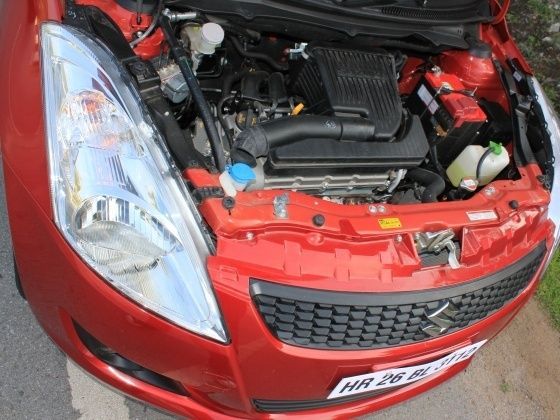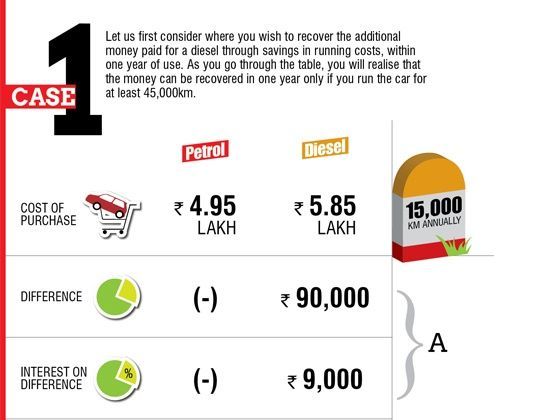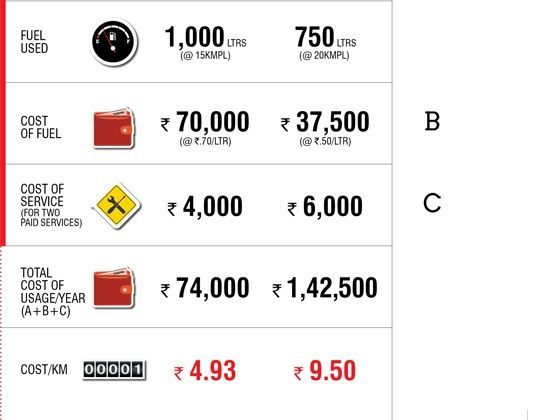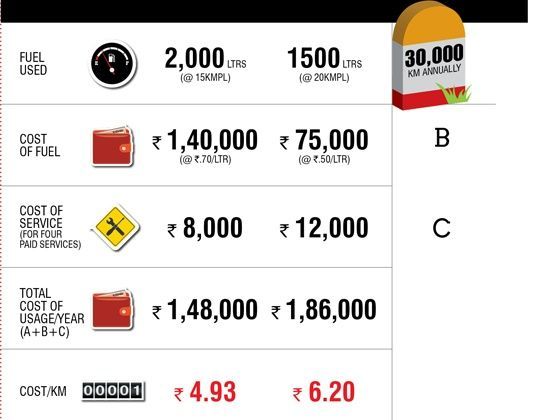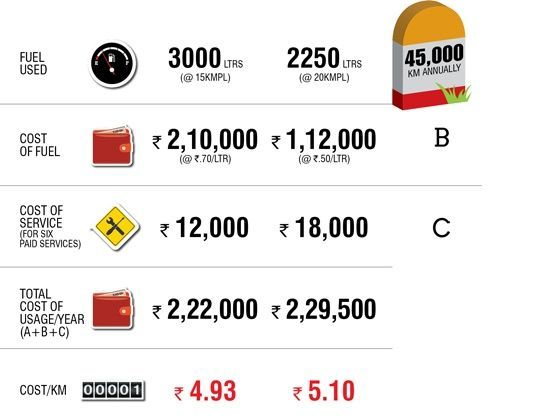India is a very price sensitive market where
customers are ready to shell out an extra penny only if it provides more
reliability or durability. Diesel engines require an extra investment but may
reduce cost of ownership for the owner, thus explaining their huge
popularity.br />
Customers’ opinion on diesel engines generally
comes under two broad categories. Some render them to be noisy, messy and
suffocating and have no liking to them. Others opt for them for their fuel
efficiency, high mileage and more value for money, making the diesel engine a
large market.
Invented by Rudolph Diesel, the world knows the
diesel engine as a powerful powertrain with outstanding pulling power, fuel
efficiency and longevity.
Diesel engines are used in automobiles,
generators, boats and have varied applications with agricultural applications.
Turbo-charged diesel engines are also used in two-wheelers like motorcycles.
The Working of the Diesel
engine
Diesel engines and petrol engines share several
similarities. They have number of components in common such as the crankshaft,
pistons, valves, camshaft, and coolant and and oil pumps. However, a key
difference between the two is that the diesel engine lacks an ignition system.
Instead of relying on a spark for ignition (as in petrol engines), a diesel
engine uses heat produced by compressing air in the combustion chamber to ignite
the fuel. All other systems used in the diesel powered vehicles are essentially
the same as those used in gasoline vehicles, and we refer to the article
published last week on petrol
engines.
Ignition system in diesel
engine
In a diesel engine, fuel injection is used. Fuel
is supplied to a Fuel injection pump and from there to injectors positioned on
each cylinder. Timing and pressure is set to inject a fine spray of diesel at
the end of the compression stroke. The heat of compressed air entered into the
cylinder then ignites the fuel and thus begins the power stroke.
Fundamentally, using compressed, hot air as well
as diesel spray ensures that the air and diesel particles can mix better so that
ignition can take place.
Glow plugs are used in diesel engines only to
warm the combustion chamber when engine is cold. As the above explained, the air
in the cylinder needs to be hot to ignite the diesel spray. Hence, cold starting
is impossible without these plugs because even the high compression ratios
cannot heat cold air enough to cause combustion. Thus when you’re just starting
your engine, these glow plugs will warm up the air in the combustion
chambers.
Schematic comparison of Diesel and
Petrol technology
|
Gasoline |
Diesel |
| Intake |
Air/Fuel |
Air |
| Combustion |
Spark ignition |
Compression ignition |
| Air/Fuel Mixing point |
In intake manifold near intake valve |
In cylinder near Top dead center by Injection |
| Compression ratio |
8 -10 to 1 |
13-25 to 1 |
| Pressure |
464 Psi |
1200 Psi |
| Exhaust |
704- 982 degree centigrade, CO =1% |
371-482 degree centigrade CO=0.5% |
| Efficiency |
22-28 % |
32-38% |
Let’s take a look at the differences and clarify
on why they exist.
First of all, as explained before, in diesel
engines, there is a separate injection for diesel fuel into a diesel engine’s
cylinder, as opposed to the common intake valve in petrol engines, where fuel
and air are injected in one go into the intake valve.
This also means that in petrol engines,
explosion takes place near the fuel intake valve itself, whereas for diesel
engines this takes place properly in the chamber. For the curious ones, it is
this property which makes the two stroke engine still allowable for large power
diesel engines (such as in trains or ships) as the combustion is much more
complete even in a two stroke engine (less leakage), thus combining the power of
the two stroke engine with a high efficiency.
The compression in diesel engines needs to be
much higher to ensure a proper combustion, compared to the more easily ignitable
petrol fuel. As you see, the compression is almost double.
As a result the pressure (1200 Psi vs 464 Psi)
is also more than double!
The temperature of the diesel’s exhaust fumes is
less than petrol engines, due to the technology used, and also, the amount of
noxious gases is also less in petrol gases.
Finally, all this culminates in a higher fuel
efficiency for diesel engines.
Types of Diesel Engines
Diesel engines come in both two stroke or four
stroke engines, differing from petrol engines only in their ignition systems.
Large diesel vehicles usually use 2-stroke configuration for simplicity though
passenger vehicles tend to have 4-stroke configuration. Over the years,
variations have been developed for diesel engines. Let’s take a look at some
engine types.
CRDi Engine
Common Rail Direct Engines are favourites
amongst Mahindra automobiles in India. Globally, they are widely used by Fiat
automobiles which are known to be extremely robust cars. In India, apart from
Mahindra, Hyundai Accent, Ford Motors and BMW automobiles widely use CRDi
engines. They are variation of direct injection engines but are less noisy, less
messy and cleaner.
More specifically, in CRDi engines, there is a
‘common rail’ containing the diesel to be injected into the cylinders. This
common rail serves as an accumulator for fuel and pressure to spray the diesel
is built up in this common rail, instead of in the individual injectors thus
allowing better control of the pressure and uniform pressure while injecting.
Importantly, as the pressure in the diesel (needed for spraying) is built up in
a different component, the pressure can be maintained consistently, so that the
engine is more efficient and smoother.
TDI Engine – Turbo-charged Direct
Injection
The TDI engine is a technology developed by the
Volkswagen group. In these engines, a turbocharger is added to the multi-jet
fuel injection engine which helps in increasing the performance of the engine.
This turbo charger further compresses the air which is provided to the cylinder,
while keeping it cooled as well, thus increasing the amount of air which is
available to ignite the diesel spark.
The result of the larger amount of air is that
more fuel can be injected for combustion, while this combustion is also more
complete. It thus reduces emissions drastically making diesel engines cleaner,
while the power of the car is also increased.
Initially seen in VW Group cars, turbodiesels
are now also used by BMW, among others.
Multi-jet Fuel injection Engine
Multi jet diesel engines are what Fiat Group
companies call their common rail diesel engines. These are the engines that in
India power Maruti cars, such as the Maruti Swift Dzire, Suzuki Swift Diesel,
Tata Cars, such as the Indica, and of course Fiat Group cars, including the
Palio.
These engines were developed by Fiat Group and
feature Common Rail technology, but also Turbo technology, compressing the air
further before combustion.
Naturally Aspirated
They are direct injection engines without a
turbocharger. Then engine draws the air through air filter which passes through
a monitoring meter into the combustion chamber. They produce less power and also
have low pulling power. They are generally used to make automobiles cheaper as
turbocharged engines are more expensive than naturally aspirated ones.
Benefits of Diesel Engines
- Fuel Efficiency
In a weight to weight comparison, diesel per volume
unit contains more energy than petrol, i.e. it has a higher calorific value.
Thus, if a complete ignition of diesel takes place, the engine will deliver more
power than a petrol engine. Equivalently, a smaller amount of diesel is needed
to deliver a certain amount of power. As a result, the diesel car’s mileage is
better than the petrol car’s.
At the same time, with diesel fuel cheaper
than petrol fuel (since diesel is unrefined and thus requires less work from the
oil company), the running cost of a diesel engine becomes lower than a petrol
engine’s.
Hence, if you have been thinking of a hybrid car but limited by
its price, then think of diesel engines. Although diesel engines cannot deliver
the eco-friendliness of hybrid models they can definitely match the fuel
efficiency.
- Safety
Diesel engines are safer than gasoline engines. They are less
volatile than the petrol engine which means they are less likely to explode in
case of a car crash
- Longevity
Diesel engines last longer as they are less prone to wear
and tear. This makes diesel automobiles more cost effective. Moreover, vehicles
used for long runs opt for diesel engines. Diesel engines require less
maintenance and are robust in nature.
However, maintenance when
undertaken for a diesel engine, will be more expensive than for a petrol engine,
as it is a more complex technology. Similarly, the initial investment for a
diesel vehicle is also more, for the same reason.
Thus, the buyer should
ideally offset the investment and maintenance expectation against the savings to
be expected from the better mileage.
- Torque or Pulling Power
Diesel engines have greater pulling power
which clubbed with their tendency to last longer converts commercial and
passenger vehicles to more value for money. However, acceleration is less for
diesel engines.
- Environment
It may be surprising to you, but diesel engines are
considered as cleaner than petrol engines. This is due to a more complete
combustion. Hence, though the emission in diesel engines is more visible
(dusty), petrol engines emit invisible noxious gases.
An interesting
recent development is bio-diesel, which is a animal or vegetable fat based fuel
which has properties equivalent to diesel.

Do read this more thorough analysis
and comparison of petrol and diesel engines for more information. as well as
this comparison
of petrol, diesel and LPG.
Conclusions
With the steep increase in price of petrol every
fortnight, there is an increased tendency to go for diesel engine cars as the
trade off between the investment of the diesel engine and its lower running cost
is tipping. This has resulted in almost all manufacturers coming up with both
petrol and diesel version their car models. The present generation diesel
engines have started to overcome earlier defects such as cold starting problem
(waiting for the glow plug to heat the air before starting the engine) as well
as improved noise reduction technology to overcome excessive noise from diesel
engines.
The improvements have resulted in smoother
operation of the diesel engines, though the difference to the petrol engines
version remains around rs 75,000. Hence customers may remain in dilemma whether
to invest high for diesel engine version or to go for petrol version.
Our earlier articles on selection between petrol
and diesel engines and alternative fuels will certainly help in this regard.
We hope the above has shed some light on the
working of the diesel engine and its advantages. We remind you that much
technology between diesel and petrol is similar, and thus you should read both
articles in conjuction.
Maintenance of your diesel
car
Maintenance plays a major role in controlling
smoke. Good maintenance is a must to get low smoke levels - or vice versa, low
smoke levels show good maintenance. Improper maintenance affects the injection
characteristics and quantity of lubricating oil which pass across piston rings
and thus exercise a significant effect on engine tendency to generate smoke.
Following the scheduled maintenance as mentioned
in particular car owner manual is needed to ensure good condition.
Diesel odour and its control
The general complaint with diesel vehicles is
about their foul smell or odour. It is due to products of oxidation of fuel in
exhaust. The partial oxidation may be because of very lean mixtures of fuel and
air such as during idling or due to quenching effect. Factors such as Fuel/air
ratio, Engine operation mode, engine type, fuel consumption affect odour
production.
Though many manufacturers claim that odour
additive compounds can reduce intensity of odour, it has been found in practice
that these hardly have any effect.
Source:cartrade.com


